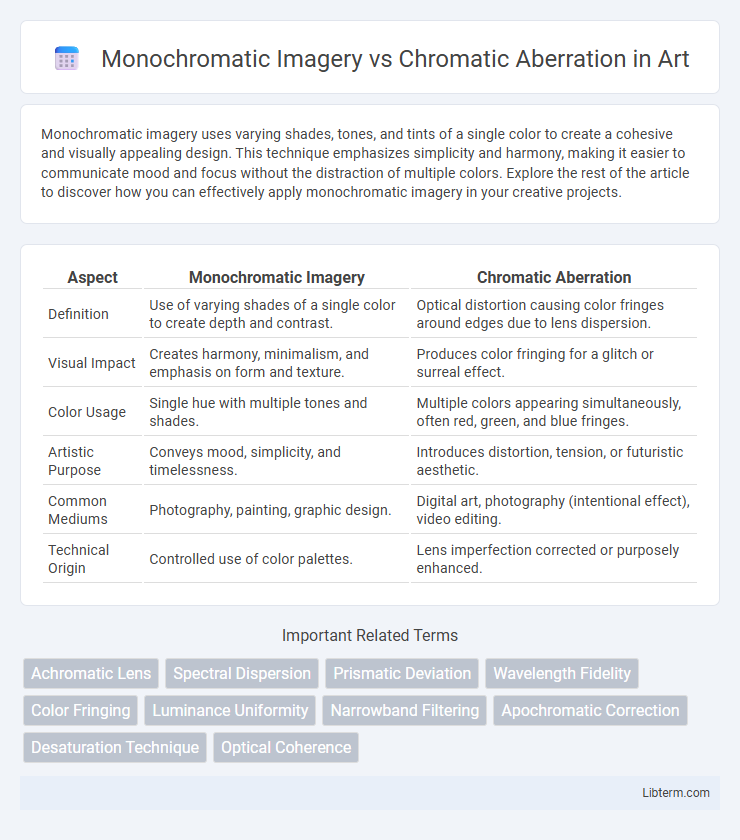Monochromatic imagery uses varying shades, tones, and tints of a single color to create a cohesive and visually appealing design. This technique emphasizes simplicity and harmony, making it easier to communicate mood and focus without the distraction of multiple colors. Explore the rest of the article to discover how you can effectively apply monochromatic imagery in your creative projects.
Table of Comparison
| Aspect | Monochromatic Imagery | Chromatic Aberration |
|---|---|---|
| Definition | Use of varying shades of a single color to create depth and contrast. | Optical distortion causing color fringes around edges due to lens dispersion. |
| Visual Impact | Creates harmony, minimalism, and emphasis on form and texture. | Produces color fringing for a glitch or surreal effect. |
| Color Usage | Single hue with multiple tones and shades. | Multiple colors appearing simultaneously, often red, green, and blue fringes. |
| Artistic Purpose | Conveys mood, simplicity, and timelessness. | Introduces distortion, tension, or futuristic aesthetic. |
| Common Mediums | Photography, painting, graphic design. | Digital art, photography (intentional effect), video editing. |
| Technical Origin | Controlled use of color palettes. | Lens imperfection corrected or purposely enhanced. |
Understanding Monochromatic Imagery
Monochromatic imagery uses varying shades of a single color to create depth and contrast while maintaining visual coherence, often employed in black-and-white photography and design to emphasize texture and form. Understanding monochromatic imagery involves recognizing how lightness and darkness within one hue can convey emotion and detail without the distraction of multiple colors. This technique enhances focus on composition and structure, making it a powerful tool in artistic and scientific imaging.
Defining Chromatic Aberration
Chromatic aberration, also known as color fringing or dispersion, is an optical phenomenon where a lens fails to focus all colors to the same convergence point, resulting in blurred or distorted edges in an image. This occurs because different wavelengths of light refract at slightly different angles when passing through a lens, causing separation of colors along object borders. In contrast to monochromatic imagery, which captures a single wavelength or color channel, chromatic aberration introduces unwanted color shifts that degrade overall image sharpness and fidelity.
Visual Impact: Monochrome Versus Chromatic Distortion
Monochromatic imagery emphasizes clarity and contrast by using a single color spectrum, enhancing visual impact through simplicity and tonal depth. Chromatic aberration introduces color fringing and distortion at image edges, which can create a dynamic, surreal effect but often reduces overall sharpness and clarity. The choice between monochrome and chromatic distortion depends on whether the goal is to achieve a clean, focused aesthetic or an edgy, visually disruptive experience.
The Science Behind Light and Color
Monochromatic imagery relies on a single wavelength of light, producing images with uniform color and sharp contrast by eliminating chromatic dispersion. Chromatic aberration occurs when lenses fail to focus multiple wavelengths at the same convergence point, causing color fringing and blurred edges. Understanding the refractive index variations across the visible spectrum explains the optical challenges in controlling light and color in photography and imaging technology.
Applications of Monochromatic Imagery in Art and Design
Monochromatic imagery employs variations of a single hue to create depth, contrast, and emotional impact, widely utilized in minimalist art and branding for its cohesive and elegant aesthetic. Designers leverage monochromatic palettes in fashion and interior design to evoke harmony and sophistication while emphasizing texture and form over color complexity. This technique enhances visual storytelling and accessibility by reducing distractions, making it ideal for conceptual artworks, logos, and digital interfaces.
Chromatic Aberration: Causes and Effects in Optics
Chromatic aberration arises from the dispersion of light as lenses refract different wavelengths unevenly, causing color fringing and blurred image edges. This optical distortion occurs because shorter wavelengths (blue/violet) bend more than longer wavelengths (red/orange), leading to focal length variations across colors. The resulting effects reduce image sharpness and color accuracy, posing challenges for high-precision lenses in photography, microscopy, and telescopic optics.
Aesthetic Choices: Intentional vs. Unintentional Color Use
Monochromatic imagery relies on deliberate, intentional use of a single color or varying shades to create a cohesive and minimalist aesthetic that emphasizes form, texture, and light. Chromatic aberration, often considered an unintentional color distortion caused by lens imperfections, introduces unexpected color fringing that can either be corrected or embraced as a creative, glitch-inspired effect. The choice between these approaches reflects the artist's intent: precision and control with monochromatic palettes versus spontaneity and imperfection with chromatic aberration for dynamic visual impact.
Technical Solutions: Minimizing Chromatic Aberration
Minimizing chromatic aberration involves using advanced optical designs such as apochromatic lenses that combine multiple glass types with different dispersion properties to converge light wavelengths more accurately. Precision coatings and aspherical lens elements reduce color fringing by minimizing light wavelength separation and optimizing focal points. Digital correction techniques in post-processing further refine image quality by compensating for residual chromatic distortions detected during image capture.
Comparisons in Photography and Film
Monochromatic imagery commonly employs a single color or varying shades of one hue to evoke mood, emphasize texture, and enhance composition, whereas chromatic aberration is an optical distortion caused by lens dispersion, resulting in color fringing around high-contrast edges. In photography and film, monochromatic schemes intentionally create a timeless or artistic effect, while chromatic aberration often appears as an unintended flaw that reduces image sharpness and color accuracy. Advanced editing techniques and quality lenses minimize chromatic aberration, whereas monochromatic imagery relies on deliberate color restriction to influence visual storytelling.
Future Trends in Image Processing and Color Manipulation
Future trends in image processing emphasize the integration of monochromatic imagery with advanced chromatic aberration correction algorithms to enhance visual clarity and artistic expression. Machine learning techniques are increasingly used to balance monochromatic aesthetics with precise color fringing adjustments, enabling dynamic and context-aware image enhancements. These developments promise improved accuracy in medical imaging, augmented reality, and cinematic color grading by harnessing the synergy between monochrome detail and chromatic precision.
Monochromatic Imagery Infographic

 libterm.com
libterm.com